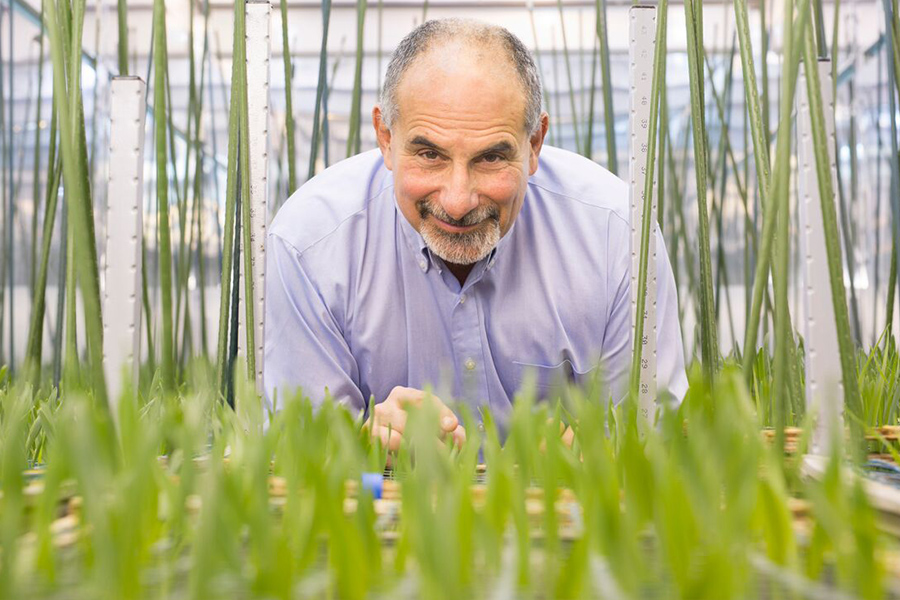
Rooting out secrets to creating better crops
Internationally recognized plant scientist Leon Kochian, Canada Excellence Research Chair (CERC) in Food Systems and Security at the University of Saskatchewan, has been granted $800,000 by Innovation Saskatchewan to equip a new research laboratory that will improve crop productivity and resiliency.
By Sarath PeirisUsing the Canadian Light Source synchrotron, the cyclotron at the Saskatchewan Centre for Cyclotron Sciences, and other advanced imaging equipment, Kochian aims to increase crop yields to feed a hungry world, whose population is expected to reach 9.7 billion by 2050.
The aim is to breed better cultivars of plants such as wheat, lentils and canola with improved root traits that help them cope with a range of soil-based stresses, including drought, low levels of essential mineral nutrients, and pathogens.
“We are using the funding from the province to take advantage of novel cutting-edge technologies associated with the U of S and Saskatchewan to look at root form and function in ways not possible until now,” said Kochian, a professor in plant sciences and soil science in the College of Agriculture and Bioresources, and associate director of the U of S Global Institute for Food Security (GIFS).
Along with provincial funding through the Innovation and Science Fund (ISF), the Roots of Food Security laboratory received $800,000 from the Canada Foundation for Innovation (CFI), $9,000 from the U of S, and $391,000 from in-kind vendor contributions to provide cutting-edge technology.
“The advances in fundamental research made at this laboratory by these talented researchers will position Canada strategically to address global food security challenges by driving change in agricultural and food security technologies, practice and policy,” said Karen Chad, vice-president Research at the U of S.
A significant part of research will focus on plant root systems, root architecture and root function in acquiring the mineral nutrients, nitrogen, phosphate and potassium, and water under drought conditions.
“To do this, we have been developing more sophisticated tools for imaging root architecture and function of roots grown both hydroponically and in soil,” said Kochian.
“It turns out that plants have a significant genetic control over how they distribute their different root types in three dimensions in the soil. That’s turning out to be a very important trait for improved nutrient and water acquisition efficiency of plants.”
With CERC money, Kochian has hired two faculty members, a computational biologist from Cornell University and a plant molecular and cell biologist from University of California Davis. He is in the process of hiring two more researchers for the highly multidisciplinary work being done at the facility.
The program will provide unique training opportunities for the next generation of agriculture scientists. Kochian foresees up to 15 post-doctoral fellows and up to 15 graduate students training in the laboratory.
“We are hiring world-class faculty, and attracting top scientists,” he said. Post-doctoral fellows so far have come from the United States and Mexico, and as far away as China, Japan and India.
Ultimately, the research will dramatically accelerate the pace of plant breeding to improve crops globally, and ensure that Canada maintains its position as a leading agricultural producer. Prairie agriculture will benefit from advances in crop resiliency and improved crop performance, he said
As well, Kochian is working to solve problems in African crops such as maize and sorghum since GIFS also focuses on agriculture in developing countries.
The ISF funding mostly will be used to purchase more lab equipment from large companies, but some money is being invested in building unique tools for sophisticated imaging of roots.
For instance, the lab group is building a three-dimensional root imaging system that enables the images to be translated into 3D reconstructions. Researchers will then be to quantify different root architecture traits from hundreds of varieties of specific crop species.
Genetic mapping of these traits can identify the genes (and associated molecular markers) leading to differences in root architecture that enable the plant to more efficiently capture water and nutrients.
“One of the biggest advances in biology in recent years has been technological,” Kochian said. ”We are often studying similar questions to what I studied earlier in my career, but now we are able to look more deeply into the underlying processes controlling these complex traits.”
Sarath Peiris is Assistant Director of Research Profile and Impact at the U of S.
